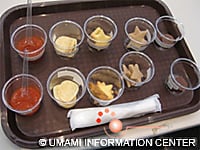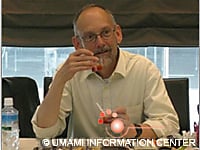' Kokumi ' Experience Report by Dr. Harold McGee
January 2013
Dr. Harold McGee is one of the most renowned food writers with a scientific background and enthusiasm for food. Taking the opportunity of his attendance at the Umami Summit in San Francisco in 2008, the Umami Information Center has had continual contact with him.
His writing to introduce umami and MSG to his followers is of great help in diffusing updated and accurate information on umami over the world. In 2010, we supported him in joining the Japanese Culinary Fellowship program in Kyoto where he widened his knowledge of and interest in Japanese cuisine and culture. This time, on his first visit to Tokyo, he had a chance to experience 'kokumi' at the laboratories of Ajinomoto and sent us a report to share his impressions and thoughts.
What is 'kokumi' ? The taste and palatability of foods have conventionally been expressed by the five basic tastes: sweet, salty, sour, bitter, and umami. However, at the same time, the development of an agent or composition capable of imparting 'kokumi' to a food has been desired. 'Kokumi' means a taste that cannot be expressed by the five basic tastes, and also includes marginal tastes of the basic tastes, such as thickness, growth (or mouthfullness), continuity, and harmony.
Related articles:
Umami Summit in San Francisco article
Dr. McGee's Lecture in Kyoto article
" 'Kokumi' at last! "
I first heard of the taste sensation called 'kokumi' around five years ago through publications of Thomas Hofmann, a flavor chemist at the Technical University of Munich. Professor Hofmann attributed the term to a 1990 study by Yoichi Ueda and his colleagues at Ajinomoto, who found that water extracts of garlic affected the taste of soups and test solutions. The effect was not a distinctive taste of its own, but an increase in qualities that Dr. Ueda called "continuity, mouthfulness, and thickness," as well as an overall enhancement of sweetness, saltiness, and umami tastes.
Professor Hofmann uses the same description of the 'kokumi' compounds he has found and studied in cheeses and in dried beans, as well as the terms "complexity" and "long-lastingness."
These descriptions are somewhat vague, certainly less specific than "sweet" or "salty" or "sour," so I could only imagine this general flavor-enhancing effect. And I was delighted to have the chance to experience it directly when I visited the research division of Ajinomoto in Kawasaki last September.
Dr. Kumiko Ninomiya had kindly arranged for me to learn about the latest developments in research on 'kokumi', and then to taste its effects in five different foods. Each food was presented in two versions: a standard "control" recipe, and the same standard recipe to which a 'kokumi' substance had been added. This substance was a peptide molecule composed of three particular amino acids (glutamine, valine, and glycine), which I was told is the most potent 'kokumi' substance known to date, and which was added in tiny quantities, from 2.5 to 20 parts per million of the food. (By comparison, salt and MSG have significant taste effects at around 1000 parts per million).
The five foods were tomato sauce, cheese-flavored potato chips, butter cookies, cinnamon cookies, and chocolate. For me, the flavor differences were greatest for the tomato sauce and the chips, less obvious in the sweet foods. The simplest way to describe the effects is to say that with just that one kind of molecule added to the recipes, there was more going on all over my mouth.
【Tasting Sample Recipes: Tomato sauce (with 5 ppm γ-Glu-Val-Gly), Cheese flavored potato chips (with 10 ppm γ-Glu-Val-Gly), Low fat butter cookies (with 20 ppm γ-Glu-Val-Gly), Cinnamon cookies (2.5 ppm γ-Glu-Val-Gly), Milk chocolate (with 20 ppm γ-Glu-Val-Gly)】
The flavors seemed amplified and balanced, as if the volume control and had been turned up and an equalizer turned on. They also seemed somehow to cling to my mouth--a tactile feeling--and to last longer before fading away. And the effects extended to aroma as well as taste, though I imagine indirectly through the taste effects.
Quite remarkable! And a phenomenon that chefs and food manufacturers will certainly want to know more about and exploit more effectively. Of course they have already exploited it for a long time whenever they use foods that are rich in 'kokumi' compounds, which we now know include garlic and onions, fresh and dried scallops, aged cheeses, and fish sauces. But as has been true of umami, a taste that humans have always enjoyed but only recently recognized as a specific sensation, the more aware we are of taste sensations, the more we can fine-tune and enjoy them.
Harold McGee
25 November 2012



